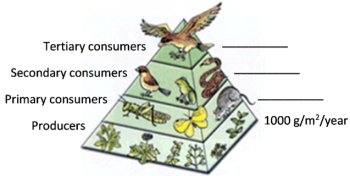Serendip is an independent site partnering with faculty at multiple colleges and universities around the world. Happy exploring!
Trophic Pyramids

In this analysis and discussion activity, students discover the reasons why (in many ecosystems) plants are more common than primary consumers, which in turn are more common than secondary consumers.
To begin, they learn about the factors that influence the net rate of biomass production. They figure out why the net rate of biomass production is lower for each higher trophic level in an ecosystem.
Then, students construct and analyze trophic pyramids. Finally, they apply what they have learned to understanding why more resources are needed to produce meat than to produce an equivalent amount of plant food.
The Student Handout is available in the first two attached files and as a Google Doc designed for use in distance learning and online instruction. The Teacher Notes, available in the last two attached files, provide instructional suggestions and background information and explain how this activity is aligned with the Next Generation Science Standards.
| Attachment | Size |
|---|---|
| trophic pyramids SH.docx | 2.78 MB |
| trophic pyramids SH.pdf | 262.58 KB |
| trophic pyramids TN.docx | 63.51 KB |
| trophic pyramids TN.pdf | 153.4 KB |











Comments
2025 revision
Some of the questions and diagrams have been clarified.
Ingrid
2024 revision
The Student Handout now includes an introduction that clarifies the difference between gross and net rates of biomass production and motivates the use of net rates of biomass production in the construction of trophic pyramids.
Ingrid
Post new comment